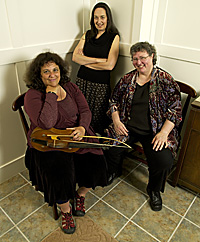When Margriet Tindemans, director of The Medieval Women’s Chorus, finally accepted a request from one of her chorus members to present a program of Jewish Medieval music, she couldn’t have anticipated how much of a challenge this would turn out to be.
Tindemans, a world-renowned musicologist who has taught and performed on four different continents, is an Early Music specialist. She is quite accustomed to having to search for examples of music, to perform historically informed arrangements, and to direct and teach ensembles in performance practices particular to the region and time represented by the music. In the case of this concert, however, she discovered that there are only two known fragments of Jewish Medieval music in the world, both captured by a 12th-century cantor and teacher named Obadiah.
Obadiah, formerly known as Giovanni, was an Italian nobleman and Christian who converted to Judaism, and then moved to Egypt. From his writings, only six lines of a longer strophic song exist to give us a glimpse of what the music of the day sounded like.
In a lecture she recently gave to her chorus about the history of this music, Tindemans explained that there were many reasons for the lack of musical examples from this period. One was that the music was based on an oral tradition, meaning that its creators either taught or passed along by learning the music by ear rather than by writing it down. Also, the music — predominantly sacred — was considered the intellectual property of the cantors.
A lot of pride and secrecy surrounded the individual cantor’s interpretation and embellishments of the traditional Hebrew sung prayers. Hazzans, as they’re known in Hebrew, would not want to make these available by writing them down. In addition, the hazzans were often expected to improvise, creating new melodies or ornamentations on the spot, in which case they would sometimes use non-Jewish musical references.
In addition was the practical problem of the music being written left to right, while Hebrew is written from right to left. Not until the 17th century was Jewish music found in manuscript, and this was accomplished by writing the music backwards.
So, other than the fragments found written in Obadiah’s hand, how do we know anything about music during this period? The writings of rabbis commenting against music included in religious services have told us a lot. Many moral and ethical questions surrounded the role that music played in religious ceremonies — a controversy that continues even today.
Maimonides famously wrote that music was too distracting to the service and should therefore be considered sinful, and certainly not worthy of writing down. Luckily for music lovers, his opinion was in the tradition of being open to interpretation.
The years known as “Medieval,” or more commonly the “Middle Ages,” extend from 400 C.E. to approximately the end of the 13th century. Because of the scarcity of sources for an authentic Jewish Medieval music program, Tindemans has chosen to create a program that reflects the oral tradition of passing music down to show how Jewish melodies and themes from an earlier time are reflected in later ages.
The concert will mix choral, vocal solo and instrumental music. Joining the choir will be Tindemans on viola de gamba (a Baroque-era viola), and singer/instrumentalist Shira Kammen on vielle (a medieval stringed instrument similar to the violin) plus Mmedieval harp. The concert will also feature soprano soloist Linda Strandberg.
Included in the program will be a rarely heard repertoire, representing several aspects of music from Jewish culture. The choir will sing cantillations, a term known in the synagogue as ritual chanting of Bible texts such as the “Song of Songs,” but adapted to a choral setting. Also planned are piyyutim, or liturgical poems: the strophic songs that became so popular during the 11th and 12th centuries. An example of a well-known piyyut is “Adon Olam” (“Master of the World”), sometimes attributed to Solomon ibn Gabirol from 11th-century Spain. Nigunim, a form of vocal instrumentalizing which translates as a “humming tune” in Hebrew, will be included, as well as the secular Sephardic Romanzas (narrative ballads) and Coplas (strophic songs) in Ladino that originated on the Iberian peninsula and were sung until the Jewish expulsion in 1492. These last songs especially intrigue Tindemans, because the melodies seem to have blended traditional western European, Jewish and Arabic elements. What she found, she said, was a “rich cross-fertilization of culture at the courts in Spain, where Christians, Muslims and Jews worked and performed together.”
As such, they reflected a time when the three major religions lived side by side in relative harmony. With the violence in the world today, it’s a welcome reminder of such times in our past. In the courts of Cordoba, a Muslim caliphate and the Christian court of Alfonso X in Castilia, Jewish philosophers and writers were appreciated because of their knowledge of Greek and Arabic, as well as of Hebrew.
They worked as mediators between Islamic and Christian cultures, and were also valued as poets and musicians: records exist of Jewish musicians, known for their skillful singing or playing of string instruments, being hired for all kinds of festivities, even to perform in Christian religious services! There is a dramatic difference between the relative freedom enjoyed by 13th-century Spanish Jews to the Ashkenazi from the Germanic countries who were excluded from guilds and societies, and barred from public office.
Locally, Dutch-born Tindemans is best known for her involvement with The Seattle Early Music Guild, where she has directed biennial Medieval music workshops since 1990, the same year that she created the Medieval Women’s Choir. She has also taught early music at the University of Washington and is the former director of the Northwest Center for Early Music Studies. With over 40 years of performing and teaching under her belt, this new ground Tindemans is breaking could make for an extraordinary concert.
Playing in the key of harmony
